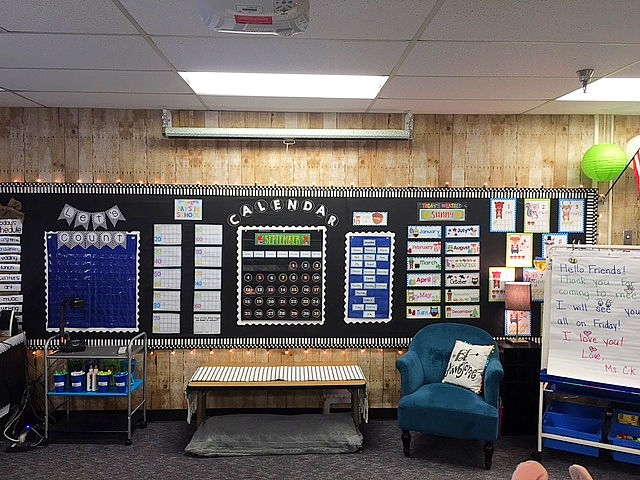Ten Ways to Make Your Classroom Feel Homey
- Emily
- May 15, 2018
- 4 min read
Ever walk into your new classroom and instantly feel like you're in a prison? Well that's exactly how I felt the first time I saw my room. White chipped paint walls, gray counters, stained tile floors, throw-up brown collapsible walls, ugly casino carpets, you name it! I had it all in my classroom! I knew that if I allowed my classroom to look like a prison cell or just look like I could care less, my students would treat it that way. So the mission began! After two years of moving schools I discovered many tricks and tips to use to make the ugliest of classrooms feel a little bit more like home! Here are my top ten favorites tricks:
1. Cover the walls-tastefully.
In my classroom I covered my "staple-able" collapsible shared room wall as well as my actual regular wall in fake wood. The wood is from Hobby Lobby as a butcher paper material found in their fade-less bulletin board paper selection. This natural brown texture adds instant warmth and homeyness to any classroom. This is by far my most favorite aspect of my classroom. I have used both the regular wood paper texture and the ship-lap wood textured paper...
>>>Regular Wood:


>>>Ship-lap Wood:


To learn more about my wood walls click HERE.
2. Dim the lights, and teach with them dimmed.

Before the first day of school when my room is decorated and finally (almost) ready for the kids, I will spend a few minutes deciding the preferred lighting. In this particular room that I have now, I only want my teacher table and counter light, so I placed two stickers that were two different colors to represent my lighting choice. This way when I have a student turn on the lights I will tell them "Only turn on the two apples" or "Only turn on the green apple light" ect. Being selective with your lighting will ultimately affect the calming factor of your room. It also helps hide the ugly, dirt, and any mix match color schemes in your room a little bit better! Another plus!
3. Add as many, many, MANY lights and lamps as you can.
In my classroom I have 4 lamps, and 3 large lined areas in twinkle lights. Using lamps and lighting when your florescent classroom lights are off, will add more of a warm alternative light to your space. Not so "doctor office" and more "coffee shop" vibe.
4. Add personal touches.

I have put up pictures of me and my husband ( and of course my dog!) on the side of one of my ugly metal file cabinets. Decorating this empty space with photos, a lamp, twinkle lights, an of course a lightbox have created a happy little corner. Add touches to your desk and odd spaces to make your space feel complete.
5. Use natural lighting and curtains.
Open the blinds...all the way and let the sunshine in! Use any and all of the natural lights you can in your room to help light the room (especially if you have your lights off most of the time like me). Also, adding curtains to you room gives a nice soft contrast to the hard space a classroom often becomes.


My curtain isn't on my windows but actually hides curriculum in shelving above my sink! Hides the ugly and add a nice homey touch.
6. Incorporate real household furniture.
Garage sales and thrift stores will be your best friend. Check your local Goodwill and Value Village for used furniture all year long to find tables, lamps, chairs and more! (You can also ALWAYS find storage and office supplies at thrift stores too by the way!)


7. Add pillows and soft items.
Classrooms are naturally hard. There's tables, desks, counters, cupboards and all things linear. Adding a few soft touches such as pillows, stuffed animals and fabrics will provide a more natural contrast in the room to create the home feel.


8. Hang pictures and canvas art.
This helps make the room look more like a bedroom, adds more personal and intentional decorating aspects to the walls. Also, collages are in, so it just look fabulous too!

9. Utilize natural colors and tones in your room decor.
Using colors like black, brown, gray tan as well as colors found in nature like green, blue, yellow, and white help utilize a space to create a warm environment and not be overstimulating to your students. My color scheme is bright blue and green however I use black, gray, and brown as my accent colors to tone my two bright colors down.

Here is a before and after picture of before I used neutral tones to after the addition of brown colors.

10. Allow blank space.
Think back to art classes in high school learning about negative space and how it accents and compliments the positive working space. The same applies when decorating a room. Leaving strategic and intentional un-decorated areas create appreciation and focus on the decorated areas and also leave the room feeling complete instead of busy and chaotic.








Comments